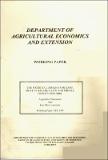| dc.contributor.author | Masomera, Augustine | |
| dc.contributor.author | Muir-Leresche, Kay | |
| dc.coverage.spatial | Zimbabwe. | en |
| dc.date.accessioned | 2015-09-11T13:54:58Z | |
| dc.date.available | 2015-09-11T13:54:58Z | |
| dc.date.issued | 1998-12 | |
| dc.identifier.citation | Masomera, A. and Muir-Leresche, K. (1998) The Potential Demand For Game Meat in Harare's Low and Middle Density Suburbs. AEE Working Paper no. 1/99. UZ, Mt. Pleasant, Harare: DAEE. | en |
| dc.identifier.uri | https://opendocs.ids.ac.uk/opendocs/handle/20.500.12413/6958 | |
| dc.description | An AEE working paper on the prospects of urban consumption of game meat in Zimbabwe low income urban areas. | en |
| dc.description.abstract | In some African countries game meat is preferred to domestic animal meat. In Zimbabwe a significant amount of game meat is being produced but little is consumed in the main urban centres. As a result the selling of game meat, especially fresh, is still unusual in urban areas. This study was premised on the underlying hypothesis that low income urban consumers are likely to become the most important segment for game meat market development. A conventional meat alternatives become more expensive this demand will expand.
This study uses buffalo, elephant, impala and warthog to determine the response of urban consumers to the possibility of widespread consumption of these meats. The study indicates that game meat could be sold in the middle and high density residential areas of Harare. Buffalo and impala are preferred to elephant and warthog. Sixty eight percent of the respondents have tasted at least one of these animals. Eighty six percent of the respondents would eat impala meat, 76% buffalo, 50% elephant and 58% warthog, if it was available. The average willingness to pay for fresh meat of these animals is lower than the average beef price by some 30 percent. Labeling and identification of game meat is very important for totem, religion and preference reasons. Game meat can be sold both fresh and dried. Seventy percent of the butcheries indicated that they would sell game meat if it was made available. However beef is the most preferred type of meat. | en |
| dc.language.iso | en | en |
| dc.publisher | Department Of Agricultural Economics and Extension (DAEE) (University of Zimbabwe) (UZ) | en |
| dc.relation.ispartofseries | Working Paper AEE;1/99 | |
| dc.rights.uri | http://creativecommons.org/licenses/by-nc-nd/3.0/ | en |
| dc.subject | Nutrition | en |
| dc.subject | Population | en |
| dc.subject | Trade | en |
| dc.title | The Potential Demand For Game Meat in Harare's Low and Middle Density Suburbs | en |
| dc.type | Series paper (non-IDS) | en |
| dc.rights.holder | University of Zimbabwe (UZ) | en |


